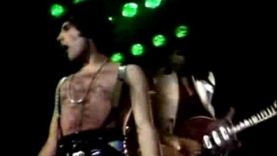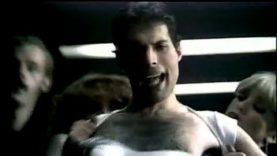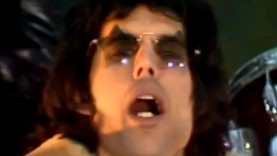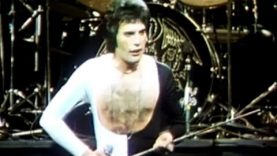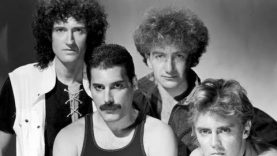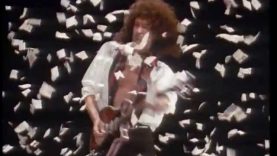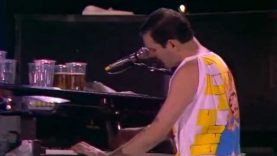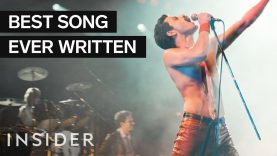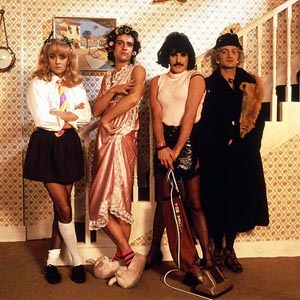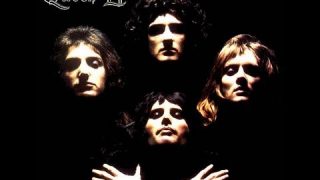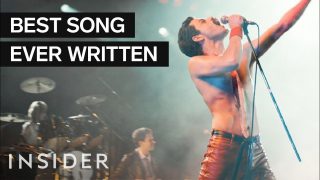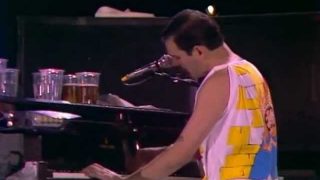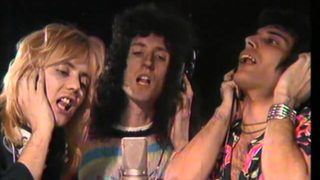Queen – I Want To Break Free (Official Video)
redrover61
I Want To Break Free
Lyrics:
[Verse 1]
I want to break free
I want to break free
I want to break free from your lies
You are so self satisfied I don’t need you
I have got to break free
God knows, God knows I want to break free
[Verse 2]
I’ve fallen in love
I’ve fallen in love for the first time
And this time I know it’s for real
I’ve fallen in love, yeah
God knows, God knows I’ve fallen in love
[Bridge]
It’s strange but it’s true, yeah
I can’t get over the way you love me like you do
But I have to be sure
When I walk out that door
Oh how I want to be free, baby
Oh how I want to be free
Oh how I want to break free
[Verse 3]
But life still goes on
I can’t get used to living without, living without
Living without you by my side
I don’t want to live alone, hey
God knows, got to make it on my own
So baby can’t you see?
I’ve got to break free
[Outro]
I have got to break free
I want to break free, yeah
I want, I want, I want, I want to break free
“I Want to Break Free” (![]() sample (help·info)) is a song by the British rock band Queen, originally from their eleventh album The Works (1984). Written by bass guitarist John Deacon, it was distributed as a single on 7-inch and 12-inch vinyl records and 3-inch and 5-inch CDs. The song has three versions: album, single and extended. It came to be included in most live concerts by the group, in several videos and in The Freddie Mercury Tribute Concert where it was sung by Lisa Stansfield.
sample (help·info)) is a song by the British rock band Queen, originally from their eleventh album The Works (1984). Written by bass guitarist John Deacon, it was distributed as a single on 7-inch and 12-inch vinyl records and 3-inch and 5-inch CDs. The song has three versions: album, single and extended. It came to be included in most live concerts by the group, in several videos and in The Freddie Mercury Tribute Concert where it was sung by Lisa Stansfield.
The song is largely known for its music video for which all the band members dressed in women’s clothes, a concept proposed by Roger Taylor, which parodied the long-running ITV soap opera Coronation Street. The second part of the video included a composition rehearsed and performed with the Royal Ballet and choreographed by Wayne Eagling. Whereas the parody was acclaimed in the United Kingdom, it was considered controversial in the United States and banned by MTV[2] and other stations. After its release in 1984, the single of the song was well received all over Europe and South America, where it was listed within top ten and regarded as an anthem of the fight against oppression. The single reached only the 45th position in the US charts, but reached number 3 in the UK and was certified silver with 200,000+ copies sold.[3]

Song
The song was written in 1983 by John Deacon and released at the beginning of April in 1984.[4] The main idea of the song lies in its title, which is repeated through the text. A love theme is also present as the protagonist “has fallen in love”, “can’t get over the way you love me like you do” and “doesn’t want to live alone”. Most of the song follows the traditional 12 bar blues progression in E major. It has three verses with one bridge, no chorus and relatively little section repetition.[5] There are three versions of the song: album, single and extended.
The album version is 3 minutes 20 seconds long. Its first 6 seconds repeat the basic rhythm played with the drums (Ludwig), an acoustic guitar (Gibson), a bass guitar (Fender) and an electric guitar (Fender Telecaster). This rhythm continues through most of the song, stopping only for its first line. The first verse ends at 0:37 and is followed by a very similar second verse, which is however shorter by one line. A stacked guitar accompaniment (Red Special) appears at the end of the second verse (1:03), and between 1:15 and 1:17 it is replaced by a synthesizer. A synthesizer solo starts at 1:33 and is assisted by a guitar. The last verse starts in the second minute, it additionally features a synthesizer and a Fender Stratocaster guitar. The song pauses at the final line “I’ve got to break free”, followed by the fade out. This version was released on the album The Works and on some singles.
The regular single version lasts 4 minutes 21 seconds and differs from the album version by the 40-second introduction and a longer synthesizer solo which starts at 2:33. The introduction is played on an electronic keyboard and is assisted by cymbals, drums and a guitar (Red Special).
The extended version lasts 7 minutes 16 seconds and features longer introduction and ending. It lasts until 6:04, and the remaining minute contains fragments of other songs from The Works. The extended version was mostly distributed as 12-inch vinyl records and then reissued on the CD of The Works in 1991.
Besides The Works, the song was featured in the albums Greatest Hits II, Box of Tricks, Greatest Hits (1992 US ‘Red’ edition) and Absolute Greatest and in the box-sets The Complete Works and The Platinum Collection.[6]
Charts and live performance
| Chart (1984) | Peak position | Held during | Weeks on chart |
|---|---|---|---|
| Australia (Kent Music Report) | 8[7] | 25 June – 1 July | 21[7] |
| Austria (Ö3 Austria Top 40) | 1[8] | 1 June – 1 July | 14 |
| Canada (RPM) | 26[9] | 16–30 June | 8 |
| France (SNEP) | 9[10] | 8–15 December | 16 |
| Germany (Media Control Charts) | 4[11] | 11–17 June | 20 |
| Ireland (IRMA) | 2[12] | 10 | |
| New Zealand (RIANZ) | 6[13] | 19 | |
| Netherlands (Single Top 100) | 1[14] | 26 May – 2 June[15] | 12 |
| Switzerland (Swiss Hitparade) | 2[16] | 17–24 June | 16 |
| UK Singles (Official Charts Company) | 3[17] | 28 April – 19 May | 15[14][17] |
| US Billboard Hot 100 | 45[18] | May[19] | 8[14][20] |
The single was received very positively over most of the world except for North America. In April 1984, it became number 3 in the United Kingdom, and was within the top 10 in many European and Latin American countries, but only peaked at number 45 on the US charts. The single was certified gold in the UK.[21] The video for the song featured Mercury in a woman’s outfit with a thick moustache, and its ban by MTV and some other US stations played a role in the low US ranking.[18] The ban was lifted in 1991 when the song was aired on VH1‘s My Generation two-part episode devoted to Queen hosted by guitarist Brian May. According to May in an interview about Queen’s Greatest Hits, whereas the video was understood and taken as a joke in UK, the US audience failed to see the soap-opera connection and might have interpreted the video as an open declaration of transvestism and Mercury’s bisexuality, which could explain why the video was banned in that country.[22][23]
In some other countries, such as South Africa and in South America, the song was highly praised because it was seen as an anthem of the fight against oppression, whereas the reaction to the video was mixed.[4][24] Illustrative in this regard was the live performance of the song in Rio de Janeiro in 1985. When Mercury appeared in front of an audience of 325,000 and started singing “I Want to Break Free”, stones were thrown at him. He quickly realised that his female outfit was the reason and removed his wig and false breasts, which calmed down the audience – they did not wish to see the song about freedom which they interpreted as “sacred” mocked. This incident however puzzled and disappointed the singer.[25][26]
After the release of The Works, the song was performed at almost all of Queen’s live concerts. Spike Edney usually played the synthesizer introduction, after which Mercury appeared on stage, often in the outfit worn in the video – dark bobbed wig, pink blouse and false breasts – which he would remove later during the song.[25][27] Brian May played the guitar solo on his Red Special. Some lines were sung by the audience, and “God knows” was chanted by the whole group. Live recordings of the song appeared on the concert albums Live Magic, Live at Wembley ’86 and Return of the Champions. In addition, the song was performed at several concerts which were then included in Queen’s videos such as Queen at Wembley, We Are the Champions: Final Live in Japan, The Freddie Mercury Tribute Concert and Return of the Champions.[28]
Lisa Stansfield led the song in The Freddie Mercury Tribute Concert.[29] She appeared on stage dressed as a housewife with a vacuum cleaner, as in the original video. The song was also performed in many concerts of the project Queen + Paul Rodgers, where Paul Rodgers took vocals, Danny Miranda played the bass guitar and Spike Edney was at the keyboard.[30]
Starting in July 2004, a remixed one-minute version of the song was featured in a Coca-Cola C2 video advertisement.[31]
Music video
The video was directed by David Mallet. It was shot on 22 March and 4 May 1984 at Limehouse Studios[32] and cost about £100,000.[25] It was included on Greatest Video Hits 2. Footage from the video was later used for the song “The Show Must Go On“.
The first part spoofed the ITV soap opera Coronation Street, as proposed by Roger Taylor: “We had done some really serious, epic videos in the past, and we just thought we’d have some fun. We wanted people to know that we didn’t take ourselves too seriously, that we could still laugh at ourselves. I think we proved that.”[33]
The video depicts Mercury as a housewife, loosely based on Bet Lynch, who wants to “break free” from his life. Although Lynch was a blonde in the soap opera, Mercury thought he would look too silly as a blonde and chose a dark wig. May plays another, more relaxed housewife based on Hilda Ogden. Deacon appears as a conservative “grandma”, while Taylor plays a schoolgirl, who like Mercury wants a different life.[18][32]
At the beginning, during the synthesizer prelude, the clip shows a common British brick terraced house (as featured in Coronation Street) and then moves into May’s bedroom. May is woken up by a Teasmade. He gets up, dressed in a pink shirt, pink socks and pink bunny-shaped slippers, with hair rollers in his head. The camera moves to the living room and the kitchen where Mercury is vacuuming the floor with a 1950 Hoover 119 Junior.[34] He wears a black wig, pink earrings, pink blouse with a sizeable false breast under it, black leather miniskirt, knee-high and heeled shoes. During the trials Mercury realised that he couldn’t walk freely in high-heeled shoes and settled on 2-inch ones.[32] His own thick moustache remains in place (although he appears without it in the latter part of the video). May descends the staircase and goes to the kitchen. He passes Deacon, who is sitting on a couch, dressed in a black cloak, gloves, grey wig and a hat. Deacon reads a newspaper, constantly snorting and shaking his head. Taylor is busy with dishwashing in the kitchen, dressed as a stereotypical schoolgirl – blonde wig, white blouse, grey miniskirt, coloured tie and a straw hat behind his back. Mercury stops vacuuming and starts singing.[25] Although he does not sing on the studio version of the song, Taylor can be seen lip-syncing some of the harmony vocals, which he did however perform in live performances.
During the first verse, Mercury opens the door of a storage room that briefly reveals a dark place, which is further used in the second verse; it appears to be a coal mine. There, the group features in their normal-life look (with Mercury naked above the waist that was common for his live and studio performances). It is surrounded by a crowd wearing black robes and miner’s helmets with headlamps. The crowd moves in sync with the music. The camera is constantly closing up on the musicians who are arranged in the same pattern as in the video for the song “Bohemian Rhapsody“. Mercury sings, while Deacon, May and Taylor just stand around him with their heads down. During the third verse, Mercury moves to another set and hides behind a big white box. In the beginning of the synthesiser solo, the box “explodes” and falls apart revealing a large stone. Mercury sits at the top of the stone, playing on a copper pipe, though the sound is of electric guitar. He is surrounded by two men and two women, all wearing the same spotty tights. In the second part of the solo, more people wearing the same outfit join in and together they perform a choreographic composition. In its first part, Mercury is carried through a row of people who pass his body over their heads. He then climbs the stone and dives in between two rows of people who catch him on the fly. After that, Mercury moves over a group of people who lie parallel on the ground and roll him over their bodies by turning around, as on a lineshaft roller conveyor. This part is finalised by a static scene of Mercury with a female dancer in a dry ice smoke.[25]
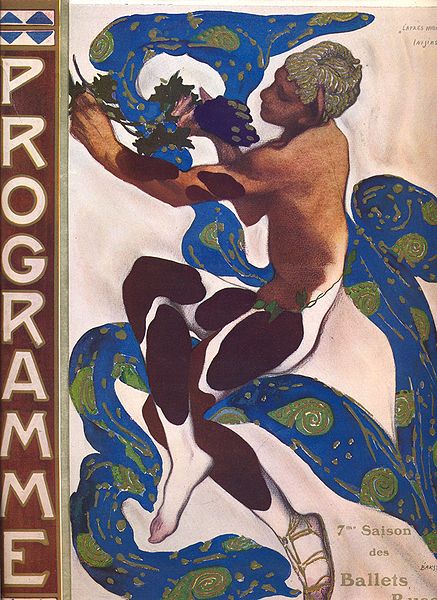
The composition was choreographed by Wayne Eagling – a friend of Mercury who had helped him before with the choreography of the “Bohemian Rhapsody”.[35] Eagling was then a leader of the Royal Ballet which was involved in the video[36] (one of the dancers was Jeremy Sheffield). Specially for this part, Mercury shaved his trademark moustache to portray Vaslav Nijinsky as a faun in the ballet L’après-midi d’un faune. The shooting took much practice, especially the conveyor rolling episode.[25] According to Eagling, despite being a natural performer on stage, Mercury could not stand performing any choreographed act himself, which is why he was mostly picked up and moved around in the ballet part of the video. The rehearsals with the Royal Ballet were organised by Eagling secretly from his superiors, something that placed him in serious trouble when discovered later.[37]
The fourth verse, with the words “but life still goes on”, returns to the Coronation Street set of the first part, with some minor changes. May, Taylor and Deacon sit in the living room, reading newspapers and magazines, including a 1957 issue of the Daily Mirror; as May and Deacon read, Taylor is doing “her” school homework beside a table. Mercury walks around them and goes up the stairs, while singing. In the final, the action moves back into the coal mine set of the second part, but this time the miners surrounding the Queen musicians move erratically.
“MTV wouldn’t play ‘I Want to Break Free’,” complained Roger Taylor. “It was a very narrow-minded station then. It just seemed to be all fucking Whitesnake.”[38]
Distribution
The song became the second single from the album The Works, after the song “Radio Ga Ga“. The single was released on 2 April 1984[39] on 7-inch and 12-inch records and later as 3-inch and 5-inch CDs.[40][41]
The 7-inch records were distributed in 16 countries. In most countries the other side of the disk contained the album version of the song “Machines (or ‘Back to Humans’)”, in the US and Canada there was an instrumental version of this song, and in Brazil the other side featured the song “It’s a Hard Life“. The label also depended on the country: Capitol Records in the US and Canada, Toshiba EMI in Japan, and EMI in other countries. In UK, US, Portugal and South Africa several records of the song were sold at the same time, differing only by covers. There were special editions, such as a record with empty side B in UK. The song title Argentina song on was “Quiero Ser Libre”.[40][41]
In all countries except for US the A side contained the extended version of the song, side B featured “Machines” and the disk had EMI label. In the US, side B had either an instrumental version of “Machines” or the album version of “I Want to Break Free” and the label was from Capitol Records.[40][41]
The single was also distributed on the 3-inch and 5-inch CDs. In the UK the 3-inch CD featured “I Want to Break Free” (album version), “Machines” and “It’s a Hard Life” and had a Parlophone Records label. In Germany, the 5-inch CD had an EMI label and contained “I Want to Break Free” and “It’s a Hard Life“, as well as the video of “I Want to Break Free”.[40][41]
Single covers contained pictures of the group from the cover of the album The Works. In countries where the single went in four different versions, each version had a picture of one Queen member, otherwise four images were placed together. The inscription “Queen. I Want to Break Free” was red, white, gold or black and the frame was red or white. The German 5-inch CD had the cover for the single of “Radio Ga Ga“. The reverse side was the same – a photo of the group on a red background, except for CDs which had a white background and no pictures.[40][41][42][43]
Sales and certifications
| Region | Certification | Certified units/Sales |
|---|---|---|
| United Kingdom (BPI)[44] | Silver | 250,000^ |
| United States (RIAA)[45] | Gold | 500,000^ |
| ^shipments figures based on certification alone | ||
Personnel
- Freddie Mercury – lead and backing vocals
- Brian May – electric guitar
- Roger Taylor – drums
- John Deacon – bass guitar, synthesizer, acoustic guitar
- Fred Mandel – synthesizer solo
Rock Band music gaming platform
The song was made available to download on 7 December 2010 for use in the Rock Band 3 music gaming platform in both Basic rhythm, and PRO mode which allows use of a real guitar / bass guitar, and MIDI compatible electronic drum kits / keyboards in addition to up to three-part harmony or backup vocals.[46][47]
In other media
In the episode “The Final Problem” of BBC‘s Sherlock, Jim Moriarty (Andrew Scott) is shown listening to “I Want to Break Free” while arriving on Sherrinford island.[48]
Subscribe to the Official Queen Channel Here http://bit.ly/Subscribe2Queen
Queen – ‘I Want To Break Free’
Click here to buy the DVD with this video at the Official Queen Store:
http://www.queenonlinestore.com
The official ‘I Want To Break Free’ music video. Taken from Queen – ‘Greatest Video Hits 2’.



